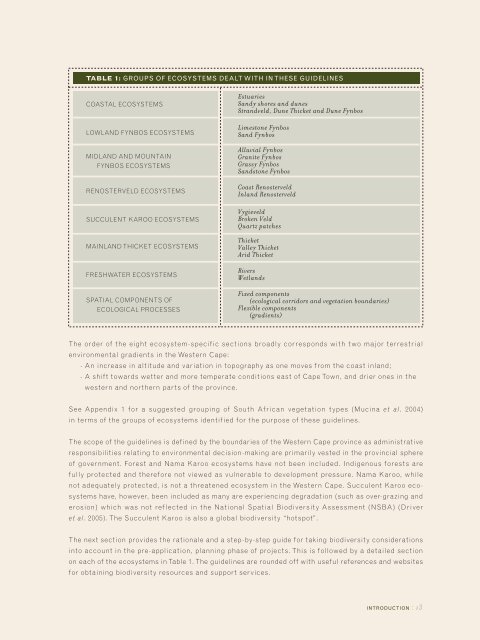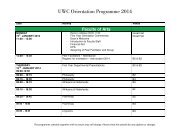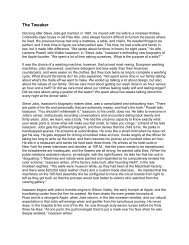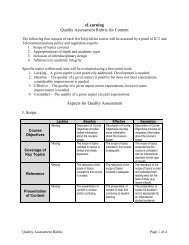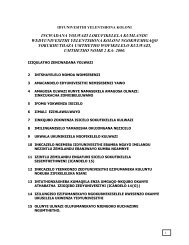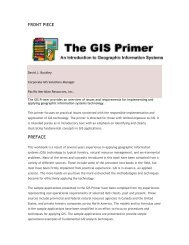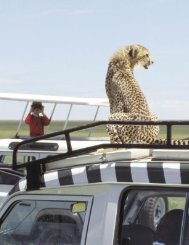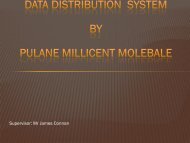Ecosystem Guidelines for Environmental Assessment
Ecosystem Guidelines for Environmental Assessment
Ecosystem Guidelines for Environmental Assessment
Create successful ePaper yourself
Turn your PDF publications into a flip-book with our unique Google optimized e-Paper software.
TABLE 1: GROUPS OF ECOSYSTEMS DEALT WITH IN THESE GUIDELINES<br />
COASTAL ECOSYSTEMS<br />
LOWLAND FYNBOS ECOSYSTEMS<br />
MIDLAND AND MOUNTAIN<br />
FYNBOS ECOSYSTEMS<br />
RENOSTERVELD ECOSYSTEMS<br />
SUCCULENT KAROO ECOSYSTEMS<br />
MAINLAND THICKET ECOSYSTEMS<br />
FRESHWATER ECOSYSTEMS<br />
SPATIAL COMPONENTS OF<br />
ECOLOGICAL PROCESSES<br />
Estuaries<br />
Sandy shores and dunes<br />
Strandveld, Dune Thicket and Dune Fynbos<br />
Limestone Fynbos<br />
Sand Fynbos<br />
Alluvial Fynbos<br />
Granite Fynbos<br />
Grassy Fynbos<br />
Sandstone Fynbos<br />
Coast Renosterveld<br />
Inland Renosterveld<br />
Vygieveld<br />
Broken Veld<br />
Quartz patches<br />
Thicket<br />
Valley Thicket<br />
Arid Thicket<br />
Rivers<br />
Wetlands<br />
Fixed components<br />
(ecological corridors and vegetation boundaries)<br />
Flexible components<br />
(gradients)<br />
The order of the eight ecosystem-specific sections broadly corresponds with two major terrestrial<br />
environmental gradients in the Western Cape:<br />
- An increase in altitude and variation in topography as one moves from the coast inland;<br />
- A shift towards wetter and more temperate conditions east of Cape Town, and drier ones in the<br />
western and northern parts of the province.<br />
See Appendix 1 <strong>for</strong> a suggested grouping of South African vegetation types (Mucina et al. 2004)<br />
in terms of the groups of ecosystems identified <strong>for</strong> the purpose of these guidelines.<br />
The scope of the guidelines is defined by the boundaries of the Western Cape province as administrative<br />
responsibilities relating to environmental decision-making are primarily vested in the provincial sphere<br />
of government. Forest and Nama Karoo ecosystems have not been included. Indigenous <strong>for</strong>ests are<br />
fully protected and there<strong>for</strong>e not viewed as vulnerable to development pressure. Nama Karoo, while<br />
not adequately protected, is not a threatened ecosystem in the Western Cape. Succulent Karoo ecosystems<br />
have, however, been included as many are experiencing degradation (such as over-grazing and<br />
erosion) which was not reflected in the National Spatial Biodiversity <strong>Assessment</strong> (NSBA) (Driver<br />
et al. 2005). The Succulent Karoo is also a global biodiversity “hotspot”.<br />
The next section provides the rationale and a step-by-step guide <strong>for</strong> taking biodiversity considerations<br />
into account in the pre-application, planning phase of projects. This is followed by a detailed section<br />
on each of the ecosystems in Table 1. The guidelines are rounded off with useful references and websites<br />
<strong>for</strong> obtaining biodiversity resources and support services.<br />
INTRODUCTION : 13


